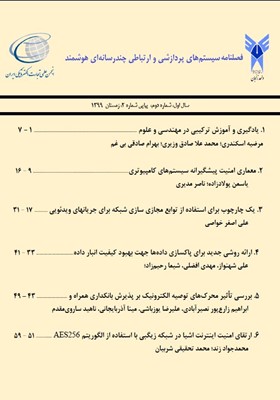یادگیری و آموزش ترکیبی در مهندسی و علوم
محورهای موضوعی : پردازش چند رسانه ای، سیستمهای ارتباطی، سیستمهای هوشمند
مرضیه اسکندری
1
![]() ,
محمد علا صادق وزیری
2
,
بهرام صادقی بی غم
3
,
محمد علا صادق وزیری
2
,
بهرام صادقی بی غم
3
1 - استادیار، گروه آموزشی علوم کامپیوتر، دانشگاه الزهرا، تهران، ایران
2 - استاد، گروه آموزشی مهندسی عمران، دانشگاه نیوجرزی، آمریکا
3 - دانشیار، گروه آموزشی علوم کامپیوتر، مرکز تحصیلات تکمیلی علوم پایه،زنجان، ایران
کلید واژه: یادگیری مسئله محور, آموزش عالی, یادگیری مبتنی بر مهارت, آموزش مجازی,
چکیده مقاله :
در این پژوهش، رویکردی برای کسب دانش بنیادی و توسعه تفکر متناسب با صلاحیت های مورد نیاز قرن 21 برای پردازش، تحلیل و ایجاد دانش ارائه می شود. به علاوه، با توجه به چالش های به وجود آمده در همه گیری کوید 19، ضرورت توسعه شیوه های نوین آموزشی مبتنی بر شایستگی به خوبی احساس می شود. روش هایی برای طراحی یک مسیر آموزشی باهدف کاهش ماندگاری تحصیلی توام با حفظ کیفیت و کسب دانش. همچنین یکی از چالش های آموزش عالی، ترس دانشجویان از عدم موفقیت در آزمون است که تاثیرات منفی بر زندگی علمی و اجتماعی فرد می گذارد . لذا، یافتن شیوه های ارزیابی مناسب نیز از الزامات اصلاح در آموزش عالی است. با شناخت این چالش ها و فرصت های آموزش عالی، یک برنامه ترکیبی از روشهای سنتی حضوری و شیوه های مدرن مجازی با استفاده از ابزارهای دیجیتال ارائه می شود، تحت عنوان آموزش و یادگیری ترکیبی: HEAL، که به اصلاح شیوه های ارزیابی نیز میپردازد.
Introduction: Despite the significant growth of theoretical teaching methods and the development of teaching aids, there are still many problems in the education system, especially in universities. In similar conditions, the challenges of education and problems after graduation in the fields of science, technology, engineering, and mathematics (STEM) are more obvious. Although today there is a large amount of research on how to deal with the issues related to the quality of education, these methods were generally not successful and most of those who finish a degree in the university, are usually unprepared. They are not required to enter the labor market. In this article, a hybrid method called HEAL is introduced, which is especially effective in STEM education. This proposed approach can be considered a combination of teaching and learning and is a transformation that leads a person from being a mere student to becoming an active learner. The main idea of this approach is based on the fact that in university, a student is expected to be a researcher of knowledge, unlike a student who acquires knowledge through education.Method: hybrid education and learning (HEAL) is a skill-based, time-based method of instruction that combines face-to-face learning and virtual learning. Proficiency-oriented, time-based education provides a model in which students who fail to earn a passing grade or complete a course during a semester are given time to demonstrate competency.Findings: The basic philosophy of HEAL is to prove the skills and abilities of students, with an approach similar to the driver's license test. This means that if the test is failed, the learner is given an opportunity to improve and try another way to demonstrate mastery. The financial capability of universities is the most important factor in making this approach operational. However, this financial burden is negligible compared to course repetition, delayed graduation, and sometimes even more academic failure. HEAL removes the fear of exams and failure and increases the love of learning.Discussion: The combination of face-to-face and virtual learning can become a wider trend in the university. While we must remember the fact that nothing can replace face-to-face training and the need for student-faculty interaction. In this research, a method for teaching in universities was discussed, in which time-based and competency-based education are combined with face-to-face and virtual learning, which can be a successful approach with the aim of reducing academic retention.
_||_


